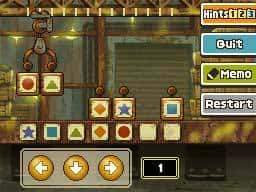You can trust VideoGamer. Our team of gaming experts spend hours testing and reviewing the latest games, to ensure you're reading the most comprehensive guide possible. Rest assured, all imagery and advice is unique and original. Check out how we test and review games here
Early on in Professor Layton and the Spectre’s Call there’s a moment where Emmy, plucky assistant to the top-hatted prof, takes a moment to reflect upon the situation at hand.
“A great archaeological find linked to a mysterious letter with an air of danger about it!” she exclaims. “I couldn’t possibly imagine a situation being more Laytonesque!”
The Professor himself doesn’t care much for Emmy’s new adjective, but she’s got a point: there’s something inherently familiar about the setup to this, the fourth game in Level 5’s series. While the giant, eponymous Spectre adds a splash of Godzilla to proceedings, arriving at night to flatten entire buildings, most of the game finds Layton and his chums walking around a quiet town, prodding the eccentric locals until they furnish him with riddles to solve.
Clearly, this is exactly what most people will want from a Layton title, but it’s hard to escape the feeling that everything is overly familiar. Last year’s Lost Future had the gimmick of time travel to keep things interesting, while the game before that, Diabolical Box, had the courtesy to give us a mysterious train ride before returning to the established crawl around town. This time we immediately head to Misthallery, another sleepy rural hamlet of winding streets and superstitious, puzzle-obsessed locals.
While the plot does eventually pick up – revealing exactly how and why Layton teamed up with Luke Triton, his schoolboy apprentice – it’s the puzzles themselves that you should be concerned with. Here too there’s a heavy element of déjà vu, with the usual spread of logic, mathematical and lateral thinking challenges. There’s nothing here that you haven’t seen before in previous outings, but at least Level 5 maintains the usual spread of diversity. Given the sheer number of teasers on offer (there are over 130) it’s still impressive that the game repeats itself so rarely. Even if you detest one particular style of conundrum – the ever-maddening sliding block arrangements, in my case – you can rest assured that you won’t have to suffer them very often.
On the rare occasions when a puzzle really does break down, it’s usually due to the limitations of the DS hardware, which is beginning to feel a bit old now. Such shortcomings are most evident when you’re asked to inspect an image to find a lone, tell-tale detail; we’ve endured these squint-inducing labours before, of course, but they seem particularly out of place at the tail end of 2011, when most of us habitually carry high-resolution smartphones, iPads, or both.
Elsewhere you’ll find a higher-than-usual percentage of puzzles that demand anomalous solutions – or “bulls***”, to use plain English. One prominent offender presents an old-fashioned clock, asking you to think of all the times of the day when the same number appears three times in succession – like 01.11, for example. The game then asks you to consider the angle of difference, moving in a clockwise direction, between the clock’s hour and minute hands. Finally, you’re instructed to state the time at which this angle will be the greatest.
Got all that? Okay, have a think about what answer you’d input.
If you said “5.55” then congratulations – because that’s what the answer would be if the game was playing fair. Unfortunately, it isn’t. I won’t spoil things by giving you the solution, but suffice to say it involves breaking the puzzle’s apparent rules. When handled correctly, setups like this can result in a satisfying “Eureka” moment; all too often, however, they simply feel like cheap tricks. It’s a concerning sign that Spectre’s Call seems to contain more of these wind-ups than previous Layton titles: The Professor’s next outing, The Mask of Miracle, will undoubtedly make use of the 3DS’ enhanced resolution and stereographic capabilities, but that won’t mean much if this manipulative sleight of hand becomes more prevalent.
Still, let’s not be too hasty to predict the future – or indeed to condemn Spectre’s Call. There’s a generous hint system in place to lend a helping hand when the game pulls one of its meaner pranks, and the fact remains that most of the puzzles here are very rewarding to work through. Level 5 may be guilty of resting on its laurels somewhat, but that’s hardly surprising when the established formula has worked so well. The art style remains as alluring as ever, the cast of picture-book caricatures feeling strangely European, despite their Japanese origins. The background music is equally likeable, although – and you may sense a theme developing here – it’s very reminiscent of previous outings.
Layton titles are usually rather generous when it comes to extras and mini-games, and Spectre’s Call proves to be no exception. The most enjoyable diversion finds you laying down tracks on a model railway, resulting in what feels like a simplified (and more colourful) version of iPhone hit Trainyard. Another game finds you placing bubbles to divert the path of a bullet-like fish, ricocheting your pet around their tank in a bid to gather up coins before a timer expires. The final distraction revolves around a puppet show; every so often the action will pause, allowing you to pick from a list of verbs to determine what happens next. While the latter is undoubtedly the runt of the litter – you can only progress if you’ve stumbled across the right verb, earned as you solve puzzles in the main game – it’s still amusing enough to be a worthy pastime, thanks largely to the swaying charm of the puppets themselves.
As agreeable as these extras may be, it’s a rough deal that the fourth – and largest – mini-game has been excised from this European release. The Japanese and North American builds of the game – published as Professor Layton and the Last Specter – offer a sizeable bonus in the form of London Life, an Animal Crossing-style RPG-lite that allows you to explore Layton’s world as a character of your own creation. London Life is reputed to contain over 100 hours’ worth of content; I clearly can’t verify or deny that claim, but it seems patently obvious that it’s something Layton’s European fans would enjoy – especially since it features characters from every game in the series to date.
The official word is that London Life was cut because translation issues would have delayed the game’s release. Be that as it may, it’s hard not to feel that we’re missing out. If you’re desperately keen to give it a go, the region-free nature of the DS means you could always import the North American version. Be aware, however, that Luke has a different voice actor in the US version.
The absence of London Life is particularly grating, as it’s arguably the lone element of Spectre’s Call (or rather, Last Specter) that tries to do something new. The game we’re left with will still please the Professor’s long-term supporters, but it’s clear that the next instalment needs to bring in a fresh idea or two. Simply being Laytonesque won’t cut it anymore.

/https://oimg.videogamer.com/images/08b6/professor_layton_and_the_last_specter_5.jpg)
/https://oimg.videogamer.com/images/b0a7/professor_layton_and_the_last_specter_1.jpg)






